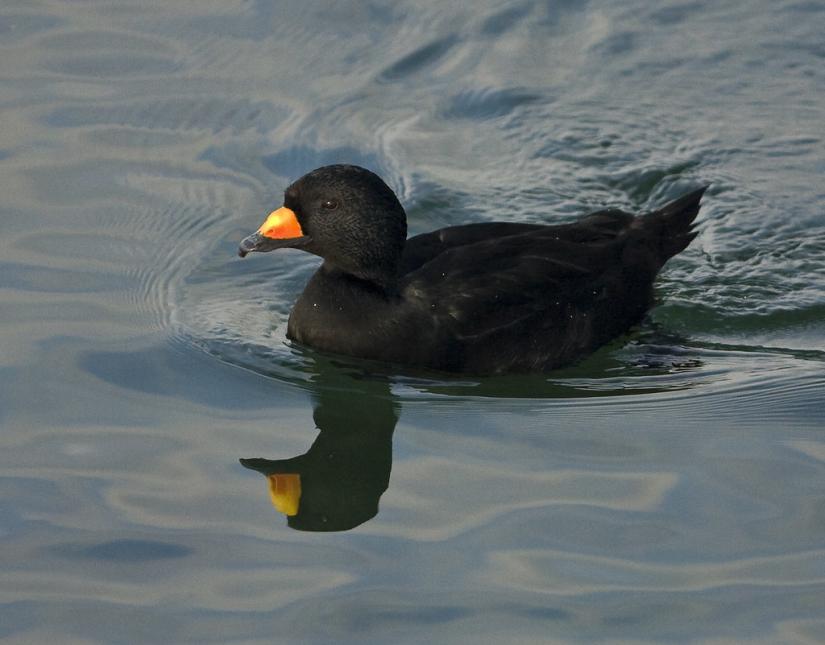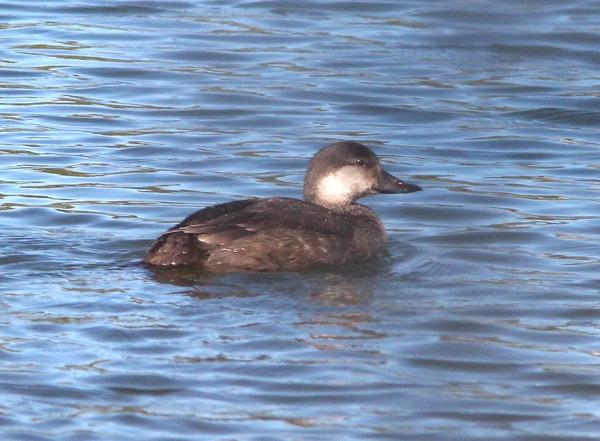Moderate
This sea duck species has undergone significant population declines on Puget Sound, where it winters. Increasing development in the Puget Sound has led to more disturbance, pollution, and degradation of foraging areas used by sea ducks. Reduction of marine forage (primarily herring spawn) may be reducing populations in some areas. Some aquaculture practices can impact foraging areas through exclusion of sea ducks.
Black scoter is managed as a migratory game bird. Sea ducks are managed under state and federal migratory waterfowl regulations cooperatively through the Pacific Flyway Council.
Description and Range
Physical description
Black scoter are about 19 ½ inches in length and weigh about 2 ½ pounds. Adult males (“drakes”) have black plumage and an orange-yellow knob at the base of their bill; in flight, their slight gray underwing may be visible. Adult females (“hens”) are dark brown with a contrasting pale face and throat.
Like all scoters, these birds move along our coasts in loose flocks, stringing into irregular, wavy lines.
For more information on how to identify this species, check out the Sea Duck Joint Venture "Meet the Sea Ducks."Also, check out the Resources section.
Ecology and life history
Black scoters breed near shallow tundra lakes in Alaska. In Washington, they frequent marine nearshore waters.
Like other sea ducks, black scoters are believed to reach sexual maturity when they are two or three years old. Courting begins in spring, and they arrive paired on the breeding grounds. Black scoters are long-lived, nest later than most ducks, and on average have low reproductive output.
Birds depart coastal molting areas from late August through November and then spend most of their annual cycle on wintering areas in Puget Sound.
The diet of black scoters in Washington is predominantly mollusks (such as mussels and clams), but also crustaceans (such as snails and periwinkles), limpets, barnacles, and vegetation. Ducks usually feed in depths less than 33 feet, diving to take prey which they then swallow whole; powerful muscles of the gizzard crush the prey, shell and all.
Geographic range
The western population of black scoters breeds on tundra of north-central Alaska Peninsula, Alaska’s Bristol Bay lowlands, Yukon-Kuskokwim Delta, and to a lesser extent in Kotzebue Sound and the Alaska North Slope. Currently, there are believed to be about 200,000 black scoters in Alaska. Their population in western Alaska has declined by about 50 percent since aerial surveys were begun in the 1950s, although recent trends appear to be stable.
In winter, black scoters are found as far south as Baja California and west into the Aleutian Islands. The black scoter is the least numerous scoter species on Puget Sound. Wintering numbers of all scoters on Puget Sound total approximately 50,000, and only about one percent are black scoters. The total scoter population index (three-year average) for Puget Sound has declined over 50 percent since 1994 to 1996, and the population may have declined as much as 78 percent since 1978 to 1979.
For maps of world-wide distribution and other species’ information, check out NatureServe Explorer and the International Union for Conservation of Nature Red List.
Climate vulnerability
Sensitivity to climate change
Moderate
Very limited information is available regarding sensitivity of black scoter to climate change, particularly in Washington. Generally, black scoter's appear to exhibit some sensitivity to climate change due to potential impacts on food availability. For example, changes in sea surface temperature, oxygen, salinity, and/or pH could lead to declines in marine forage (e.g., herring, mussels).
Exposure to climate change
Moderate
- Increased ocean temperatures
- Declines in pH, salinity, and/or dissolved oxygen
Regulations
Rules and seasons
For current rules about hunting black scoter in the state, be sure to check the Washington Game Bird and Small Game hunting regulations.
Conservation
Sea ducks are game species, managed under state and federal migratory waterfowl regulations cooperatively through the Pacific Flyway Council. The Pacific Flyway Council is an administrative body that forges cooperation among public wildlife agencies for the purpose of protecting and conserving migratory birds in western North America. The Council is composed of the director or an appointee from the public wildlife agency in each state and province in the western United States, Canada, and Mexico. Washington waterfowl hunters pursuing sea ducks in western Washington are required to record and report all harvest effort and activities, including black scoter.
WDFW has various game management plans to track populations and harvest of games species around the state, including waterfowl. These plans have information about harvest statistics from recent years, and the department's long-term vision and goals for a variety of species.
In early 2003, WDFW formed the Washington Waterfowl Advisory Group (WAG) to increase citizen involvement in the conservation and management of Washington’s waterfowl resources. This group has members from a broad representation of waterfowl hunters throughout the state. To learn about the WAG, contact the WDFW Waterfowl Section at (360) 902-2515 or visit the WAG webpage.
Conservation Threats and Actions Needed
- Resource information collection needs
- Threat: Lack of Information on status and distribution.
- Action Needed: Conduct annual winter inventory.
- Threat: Lack of information on population demography.
- Action Needed: Conduct periodic recruitment and species composition surveys.
- Threat: Range-wide delineation of Puget Sound winter population.
- Action Needed: Develop satellite telemetry study to document use areas.
- Fish and wildlife habitat loss or degradation.
- Threat: Development impacts of Puget Sound on the marine environment.
- Action Needed: Document and address limiting factors.
See the Climate vulnerability section for information about the threats posed by climate change to this species.
Our Conservation Efforts
Midwinter Aerial Seabird Surveys
WDFW conducts survey flights over a period of several days from November through February annually to monitor the abundance, trends, and distribution of sea ducks and other marine birds in the Puget Sound and the Strait of Juan de Fuca (U.S. portion of the Salish Sea). Learn more about this research on the project's page.
Resources
References
Sea Duck Joint Venture Species Fact Sheet – Black Scoter
WDFW. 2013. Washington Sea Duck Management Strategies - Draft Report to the Washington Fish and Wildlife Commission.16 pgs.
WDFW publications
Other resources
- U.S. Fish and Wildlife Service - Overview: Black Scoter
- U.S. Fish and Wildlife Service - Aerial Observer’s Guide to North American Waterfowl
- U.S. Fish and Wildlife Service - Ducks at a Distance: A Waterfowl Identification Guide
- Sea Duck Joint Venture - A Conservation Partnership under the North American Waterfowl Management Plan
- Cornell Lab All About Birds - Black Scoter
- eBird Northwest - Black Scoter

